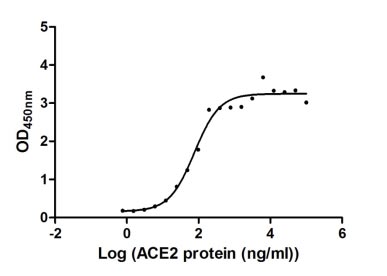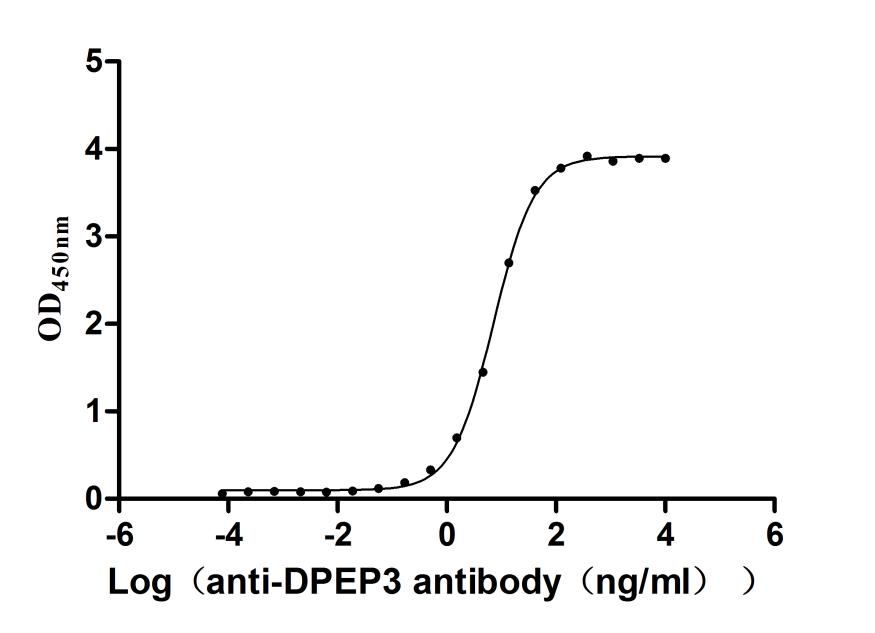Recombinant Human Acid-sensing ion channel 3 (ASIC3), partial
-
货号:CSB-YP890688HU
-
规格:
-
来源:Yeast
-
其他:
-
货号:CSB-EP890688HU
-
规格:
-
来源:E.coli
-
其他:
-
货号:CSB-EP890688HU-B
-
规格:
-
来源:E.coli
-
共轭:Avi-tag Biotinylated
E. coli biotin ligase (BirA) is highly specific in covalently attaching biotin to the 15 amino acid AviTag peptide. This recombinant protein was biotinylated in vivo by AviTag-BirA technology, which method is BriA catalyzes amide linkage between the biotin and the specific lysine of the AviTag.
-
其他:
-
货号:CSB-BP890688HU
-
规格:
-
来源:Baculovirus
-
其他:
-
货号:CSB-MP890688HU
-
规格:
-
来源:Mammalian cell
-
其他:
产品详情
-
纯度:>85% (SDS-PAGE)
-
基因名:
-
Uniprot No.:
-
别名:ACCN 3; Accn3; ACCN3_HUMAN; Acid sensing ion channel 3; Acid-sensing ion channel 3; Amiloride sensitive cation channel 3; Amiloride sensitive cation channel 3 testis; Amiloride-sensitive cation channel 3; ASIC 3; ASIC3; DRASIC; hASIC 3; hASIC3; hTNaC 1; hTNaC1; Modulatory subunit of ASIC 2a; Modulatory subunit of ASIC2a; Neuronal amiloride sensitive cation channel 3; Neuronal amiloride-sensitive cation channel 3; Proton gated cation channel subunit; SLNAC 1; SLNAC1; Testis sodium channel 1; TNaC 1; TNaC1
-
种属:Homo sapiens (Human)
-
蛋白长度:Partial
-
蛋白标签:Tag type will be determined during the manufacturing process.
The tag type will be determined during production process. If you have specified tag type, please tell us and we will develop the specified tag preferentially. -
产品提供形式:Lyophilized powder
Note: We will preferentially ship the format that we have in stock, however, if you have any special requirement for the format, please remark your requirement when placing the order, we will prepare according to your demand. -
复溶:We recommend that this vial be briefly centrifuged prior to opening to bring the contents to the bottom. Please reconstitute protein in deionized sterile water to a concentration of 0.1-1.0 mg/mL.We recommend to add 5-50% of glycerol (final concentration) and aliquot for long-term storage at -20℃/-80℃. Our default final concentration of glycerol is 50%. Customers could use it as reference.
-
储存条件:Store at -20°C/-80°C upon receipt, aliquoting is necessary for mutiple use. Avoid repeated freeze-thaw cycles.
-
保质期:The shelf life is related to many factors, storage state, buffer ingredients, storage temperature and the stability of the protein itself.
Generally, the shelf life of liquid form is 6 months at -20°C/-80°C. The shelf life of lyophilized form is 12 months at -20°C/-80°C. -
货期:Delivery time may differ from different purchasing way or location, please kindly consult your local distributors for specific delivery time.Note: All of our proteins are default shipped with normal blue ice packs, if you request to ship with dry ice, please communicate with us in advance and extra fees will be charged.
-
注意事项:Repeated freezing and thawing is not recommended. Store working aliquots at 4°C for up to one week.
-
Datasheet :Please contact us to get it.
相关产品
靶点详情
-
功能:Cation channel with high affinity for sodium, which is gated by extracellular protons and inhibited by the diuretic amiloride. Generates a biphasic current with a fast inactivating and a slow sustained phase. In sensory neurons is proposed to mediate the pain induced by acidosis that occurs in ischemic, damaged or inflamed tissue. May be involved in hyperalgesia. May play a role in mechanoreception. Heteromeric channel assembly seems to modulate channel properties.
-
基因功能参考文献:
- The present review discusses the dual nature of ASIC3 in joint inflammation with possible mechanisms. PMID: 30035658
- Acidic pH resulted in an increase in ASIC-3 expressionin the discs of paitents with intervertebral disc degeneration. PMID: 27853274
- the data demonstrate a functional link between ASICs and [Ca(2+)]i/RhoA pathway, which contributes to the acidity-induced epithelial-mesenchymal transition. PMID: 28518134
- Respiratory syncytial virus and measles virus infection upregulates ASICS3 expression in bronchial epithelial cells. PMID: 28187208
- The results show that acid-sensing ion channel 1, acid-sensing ion channel 2, and acid-sensing ion channel 3 are expressed in A549 cells at the messenger RNA and protein levels, and acid-sensing ion channel-like currents were elicited by extracellular acid stimuli. PMID: 28618956
- Blocking ASIC3 in interneurons from temporal lobe epilepsy patients decreased the frequency of action potential firing. PMID: 25476599
- These findings open new perspectives on the roles of ASIC3 in the absence of tissue pH variation, as well as on the contribution of those channels to lipid-mediated signaling. PMID: 26772186
- This study suggests that ASIC23may play a role as mediators of inflammatory pain and be involved in the pathogenesis of frozen shoulder. PMID: 26033064
- Sea anemone peptide with uncommon beta-hairpin structure inhibits acid-sensing ion channel 3 (ASIC3) and reveals analgesic activity. PMID: 23801332
- Experiments with Asic3 inhibitors show that Asic3 inhibition leads to loss of pressure-induced vasodilation due to pressure detection failure rather than endothelial mechanisms. PMID: 22842475
- The highly proton sensitive ASIC3 channels are predominantly distributed in peripheral sensory neurons, correlating with their roles in multimodal sensory perception, including nociception, mechanosensation, and chemosensation. PMID: 22778854
- CAR and ASIC3 co-immunoprecipitate only when co-expressed with PSD-95. PMID: 22809504
- Lignan from thyme possesses inhibitory effect on ASIC3 channel current. PMID: 22854960
- ASIC3 is able to sense the extracellular pH in both directions and to dynamically adapt its activity between pH 5.0 and 8.0, playing a role in fine tuning neuronal membrane potentials and neuron sensitization in various pH environments. PMID: 22829666
- The results showed that there was a significant increase in the mean relative optical density of ASIC2 and ASIC3 but not ASIC1a in the lining epithelium and glandular tubes of gastric mucosa in patients with Henoch-Schonlein purpura. PMID: 22157923
- Atomic level characterization of the nonproton ligand-sensing domain of ASIC3 channels. PMID: 21586569
- The biological features of ASIC3 is discussed and recent advances on the role of ASIC3 in the pathogenesis and treatment of arthritis pain, are summarized. PMID: 19885742
- Used coincidentally by sensory neurons to detect lactic acidosis, ASIC3 (amiloride-sensitive cation channel 3) interacts with adenosine triphosphate (ATP) to detect muscle ischemia. PMID: 21092862
- Neither ASIC3 or ASIC1 knockout influences the development or maintenance of experimental neuropathic pain after nerve injury. PMID: 20693874
- an independent association between an ASIC3 genetic polymorphism and insulin resistance in Taiwanese PMID: 20416288
- role in modulating high-intensity pain stimuli PMID: 12060708
- PSD-95 and Lin-7b interact with acid-sensing ion channel-3 and have opposite effects on H+- gated current PMID: 15317815
- Diclofenac studies show ASIC3 is a significant contributor to cutaneous acid-induced pain. PMID: 15574747
- the interaction of ASIC3 and CFTR may contribute to defective salt and fluid transepithelial transport in the cystic fibrotic pulmonary system PMID: 17012229
- These results suggest that the ASIC3 may be involved in blood pressure regulation. PMID: 18854755
显示更多
收起更多
-
亚细胞定位:Cell membrane; Multi-pass membrane protein. Cytoplasm.
-
蛋白家族:Amiloride-sensitive sodium channel (TC 1.A.6) family, ASIC3 subfamily
-
组织特异性:Expressed by sensory neurons. Strongly expressed in brain, spinal chord, lung, lymph nodes, kidney, pituitary, heart and testis.
-
数据库链接:
HGNC: 101
OMIM: 611741
KEGG: hsa:9311
STRING: 9606.ENSP00000297512
UniGene: Hs.647113
Most popular with customers
-
Recombinant Human Angiotensin-converting enzyme 2 (ACE2), partial (Active)
Express system: Mammalian cell
Species: Homo sapiens (Human)
-
Recombinant Human Poliovirus receptor (PVR) (I340M), partial (Active)
Express system: Mammalian cell
Species: Homo sapiens (Human)
-
Recombinant Macaca fascicularis Claudin (CLDN18)-VLPs (Active)
Express system: Mammalian cell
Species: Macaca fascicularis (Crab-eating macaque) (Cynomolgus monkey)
-
Recombinant Human Glucagon-like peptide 1 receptor (GLP1R), partial (Active)
Express system: Mammalian cell
Species: Homo sapiens (Human)
-
Recombinant Human C-C chemokine receptor type 6(CCR6)-VLPs (Active)
Express system: Mammalian cell
Species: Homo sapiens (Human)
-
Recombinant Human Transmembrane 4 L6 family member 1(TM4SF1)-VLPs (Active)
Express system: Mammalian cell
Species: Homo sapiens (Human)
-
Recombinant Human Dipeptidase 3(DPEP3), partial (Active)
Express system: Mammalian cell
Species: Homo sapiens (Human)
-
Recombinant Human Kidney-associated antigen 1(KAAG1) (Active)
Express system: E.coli
Species: Homo sapiens (Human)



-AC1.jpg)
















